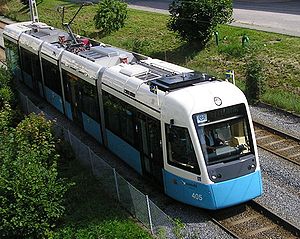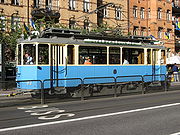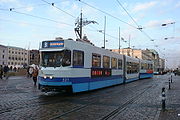
Gothenburg tram
Encyclopedia

Public transport
Public transport is a shared passenger transportation service which is available for use by the general public, as distinct from modes such as taxicab, car pooling or hired buses which are not shared by strangers without private arrangement.Public transport modes include buses, trolleybuses, trams...
system organised by Göteborgs Spårvägar AB, controlled by Västtrafik
Västtrafik
Västtrafik is the agency responsible for public transport services involving buses, ferries, trains, and the Göteborg tramway in the county of Västra Götaland, Sweden. Until 31 December 2011 the ownership is shared equally between the Västra Götaland Regional Council and the 49 municipalities in...
in the Swedish
Sweden
Sweden , officially the Kingdom of Sweden , is a Nordic country on the Scandinavian Peninsula in Northern Europe. Sweden borders with Norway and Finland and is connected to Denmark by a bridge-tunnel across the Öresund....
city of Gothenburg
Gothenburg
Gothenburg is the second-largest city in Sweden and the fifth-largest in the Nordic countries. Situated on the west coast of Sweden, the city proper has a population of 519,399, with 549,839 in the urban area and total of 937,015 inhabitants in the metropolitan area...
. The 161 km of track — making the Gothenburg tram the largest tram network in Scandinavia — is used by around 200 trams , which serve twelve day-time and five night-time lines with a combined length of 190 km. These figures are expected to increase when the second stage of Kringen (short for Kollektivringen, the public transport ring) is finished. The trams perform about 2,000 trips and cover 30,000 km per day. In 2007, 100.5 million journeys were made (with changes counting as a journey).
History

England
England is a country that is part of the United Kingdom. It shares land borders with Scotland to the north and Wales to the west; the Irish Sea is to the north west, the Celtic Sea to the south west, with the North Sea to the east and the English Channel to the south separating it from continental...
company Gothenburg Tramway Ltd. This was a horse-drawn tramway, which stretched from Brunnsparken to Stigbergsliden. The city of Gothenburg bought the tramway in 1900, and introduced electrically powered trams only two years later, when Sigfrid Edström
Sigfrid Edström
Johannes Sigfrid Edström was a Swedish industrialist, chairman of the Sweden-America Foundation, and an official with the International Olympic Committee.-Early life:...
led the electrification of the trams. During the next 40 years, the tram system was heavily expanded, reaching outside the city borders by 1907, and Hisingen
Hisingen
Hisingen is the fourth-largest island of Sweden , with an area of , and the most populous, forming part of Gothenburg Municipality, Västra Götaland County. It is bordered by the Göta älv in the south and east, the Nordre älv in the north, and the Kattegat in the west...
in 1940.
In the 1960s, plans for converting the tram system to an underground
Rapid transit
A rapid transit, underground, subway, elevated railway, metro or metropolitan railway system is an electric passenger railway in an urban area with a high capacity and frequency, and grade separation from other traffic. Rapid transit systems are typically located either in underground tunnels or on...
system were created, and the new tram sections to the Tynnered
Tynnered
Tynnered is one of 21 boroughs in the city of Gothenburg, Sweden. It is located in the western part of the city, about 8-10 kilometres from the inner city, and it has a population of 27,455 on 29.85 square kilometres ....
, Angered
Angered
Angered is a suburb in Gothenburg Municipality, Sweden. Angered is the biggest Million Programme area in Gothenburg, and one of the biggest in the country with 40 000 inhabitants....
, Bergsjön
Bergsjön
Bergsjön is a district in eastern Gothenburg, Sweden. On January 1, 2011, Bergsjön and Kortedala together became the Eastern District of Gothenburg, as a part of a larger reorganization of the City of Gothenburg where the number of district councils has been halved to ten. Bergsjön, as part of...
and Länsmansgården suburbs were built free from level crossings and partly in tunnels to make a future conversion to underground standards easier. However, after further investigation, it was concluded that it would be too expensive to dig the necessary tunnels under the city centre, as the foundation of the city is partially made up of clay.
When Sweden’s switch to right-hand traffic
Dagen H
Dagen H , today mostly called "Högertrafikomläggningen" , was the day, 3 September 1967, on which traffic in Sweden switched from driving on the left-hand side of the road to the right...
in 1967 made existing unidirectional trams obsolete, Gothenburg was one of only two cities in Sweden to maintain its city-centre tramway, the other such network to survive being the Norrköping tramway
Norrköping tramway
The Norrköping tramway network is a system of trams forming a principal part of the public transport services in Norrköping, Sweden. It has been in service since 1904, and is, along with the larger Göteborg Tramway, one of only two city-centre tramways in Sweden that survived the switch to...
.
Today, the politicians of Gothenburg seem to enjoy having a tram system in the city, even though the average speed in the inner city is very slow, and a lot of money is spent on keeping the tramway up to standards. This is realized both with the expansion of the net itself through the Kringen project which will create a tramway ring around the city centre and with the delivery of the modern Italian
Italy
Italy , officially the Italian Republic languages]] under the European Charter for Regional or Minority Languages. In each of these, Italy's official name is as follows:;;;;;;;;), is a unitary parliamentary republic in South-Central Europe. To the north it borders France, Switzerland, Austria and...
-designed Sirio
Sirio
thumb|220px|A Sirio in Athens.220px|thumb|A Sirio of [[Azienda Trasporti Milanesi|ATM]] in Milan.Sirio is a low-floor tram built by AnsaldoBreda, an Italian manufacturer of trains, trams and light rail vehicles...
trams (in Gothenburg called M32), but also with the introduction of a new fully electronic payment system.
Lines

| Line | Stretch | Length | Stops | Travel time | Average speed | Passengers/day |
|---|---|---|---|---|---|---|
| Tynnered Tynnered Tynnered is one of 21 boroughs in the city of Gothenburg, Sweden. It is located in the western part of the city, about 8-10 kilometres from the inner city, and it has a population of 27,455 on 29.85 square kilometres .... –Östra Sjukhuset |
15.59 km | 33 | 47/49 min | 19.1 km/h | 32 500 | |
| Högsbotorp–Krokslätt | 10.1 km | 22 | 31/31 min | 19.5 km/h | N/A | |
| Marklandsgatan–Kålltorp Kålltorp Kålltorp is a district in Gothenburg, Sweden which belongs to Härlanda borough.... |
12.68 km | 30 | 44/45 min | 16.9 km/h | 32 400 | |
| Mölndal Mölndal Mölndal is a part of the Gothenburg urban area on the west-coast of Sweden, and constitutes the administrative centre of Mölndal Municipality. About 40,000 of the municipality's 60,000 inhabitants live here.-Geography:... –Angered Angered Angered is a suburb in Gothenburg Municipality, Sweden. Angered is the biggest Million Programme area in Gothenburg, and one of the biggest in the country with 40 000 inhabitants.... |
19.26 km | 21 | 41/40 min | 28.2 km/h | 27 400 | |
| Torp–Länsmansgården | 13.78 km | 29 | 39/38 min | 21.2 km/h | 25 500 | |
| Länsmansgården–Kortedala Kortedala Kortedala is a district, mainly residential , in the north-eastern part of Gothenburg in western Sweden. The area houses a population of around 10,000 inhabitants and is one of the typical 1950s suburbs of Gothenburg. The area is very lush and green with many trees and parks... |
24.55 km | 46 | 71/71 min | 20.7 km/h | 43 400 | |
| Tynnered Tynnered Tynnered is one of 21 boroughs in the city of Gothenburg, Sweden. It is located in the western part of the city, about 8-10 kilometres from the inner city, and it has a population of 27,455 on 29.85 square kilometres .... –Bergsjön Bergsjön Bergsjön is a district in eastern Gothenburg, Sweden. On January 1, 2011, Bergsjön and Kortedala together became the Eastern District of Gothenburg, as a part of a larger reorganization of the City of Gothenburg where the number of district councils has been halved to ten. Bergsjön, as part of... |
21.05 km | 35 | 54/55 min | 23.0 km/h | 35 900 | |
| Frölunda Frölunda Frölunda is one of 21 boroughs in the city of Gothenburg. It is located in the south western part of the city, and is the smallest of the boroughs with a population of only 12,855 on 3.72 square kilometres, although the term Frölunda generally is used for a much wider area covering almost all the... –Angered Angered Angered is a suburb in Gothenburg Municipality, Sweden. Angered is the biggest Million Programme area in Gothenburg, and one of the biggest in the country with 40 000 inhabitants.... |
21.31 km | 25 | 46/47 min | 27.2 km/h | 19 600 | |
| Kungssten–Angered Angered Angered is a suburb in Gothenburg Municipality, Sweden. Angered is the biggest Million Programme area in Gothenburg, and one of the biggest in the country with 40 000 inhabitants.... |
18.98 km | 21 | 43/43 min | 26.5 km/h | 25 600 | |
| Guldheden–Eketrägatan/Biskopsgården Biskopsgården Biskopsgården is a district in Gothenburg Municipality, Sweden.- History :Today you can find the first trace of humans by the hillsides that was once beaches in an archipelago.... |
8.79 km | 17/23 | 24/31 / 25/32 min | 21.7 km/h | 15 600 | |
| Saltholmen–Bergsjön Bergsjön Bergsjön is a district in eastern Gothenburg, Sweden. On January 1, 2011, Bergsjön and Kortedala together became the Eastern District of Gothenburg, as a part of a larger reorganization of the City of Gothenburg where the number of district councils has been halved to ten. Bergsjön, as part of... |
21.83 km | 38 | 58/58 min | 22.6 km/h | 38 000 | |
| Planned tram line. Will have a stretch of "Norra älvstranden". | ||||||
| Marklandsgatan–Linnéplatsen | 7.24 km | 10 | 19/17 min | 22.9 km/h | 1 100 | |
| Disused tram line since 2006. Had the stretch "Centralstationen - Krokslätt" (Central Station - Krokslätt) | ||||||
| Saltholmen - Brunnsparken - (Central Station), line 104 in the timetable. | ||||||
| "Liseberg Line" streetcar line operated by veteran trams. Has stretch Central Station - Liseberg Liseberg Liseberg is an amusement park located in Gothenburg, Sweden, the park opened in 1923. Liseberg is one of the most visited amusement parks in Scandinavia, attracting around 3 million visitors annually. Among the noteworthy attractions is the wooden roller coaster Balder, voted twice as the Best... - (Sankt Sigfrids plan) |
||||||
| "Training and Event Line" streetcar line that operated at the current driver training (when not with passengers) and at special events. One example is the European Athletics Championships in August 2006 when the line sign was "Teams Tram" for the European Championship participant. |
Most tram lines pass through Brunnsparken, which is effectively the central hub of public transport in Gothenburg. The exception is line 8, which runs from Angered
Angered
Angered is a suburb in Gothenburg Municipality, Sweden. Angered is the biggest Million Programme area in Gothenburg, and one of the biggest in the country with 40 000 inhabitants....
to Frölunda
Frölunda
Frölunda is one of 21 boroughs in the city of Gothenburg. It is located in the south western part of the city, and is the smallest of the boroughs with a population of only 12,855 on 3.72 square kilometres, although the term Frölunda generally is used for a much wider area covering almost all the...
. The Central Station
Gothenburg Central Station
Gothenburg Central Station is the main railway station of Gothenburg and the third largest railway station in Sweden after Stockholm Central Station and Malmö Central Station. The station opened in October the 4th, 1858. Approximately 40 000 travelers visit the station every day. The station is...
is also a major stop, especially because it is the nearest stop not only for train passengers but also passengers coming from the neighbouring Nils Ericson Terminal
Nils Ericson Terminal
The Nils Ericson Terminal is a major bus terminus in Gothenburg, Sweden. It is placed in the city centre just next to Gothenburg Central Station , and across the street from the main Nordstan shopping centre. The main street and most hotels are within walking distance from the terminal.The...
, where coaches
Coach (vehicle)
A coach is a large motor vehicle, a type of bus, used for conveying passengers on excursions and on longer distance express coach scheduled transport between cities - or even between countries...
, airport buses to Landvetter Airport
Gothenburg-Landvetter Airport
Gothenburg-Landvetter Airport is an international airport serving the Gothenburg region in Sweden. With 4.3 million passengers in 2006 it is Sweden's second-largest airport...
and City Airport
Gothenburg City Airport
Gothenburg City Airport or Göteborg City Airport , formerly known as Säve Flygplats, is Gothenburg's second international airport, located north-west from the centre of Gothenburg on the island of Hisingen, Bohuslän, Sweden. It is located within the borders of Gothenburg Municipality, hence its...
and regional buses stop. Korsvägen
Korsvägen
Korsvägen is a public square, traffic junction and public transport hub close to Universeum, The Swedish Fair, The Museum of World Culture and the amusement park Liseberg in Gothenburg, Sweden. A major armament of the square/junction was made in the 1990s...
is another major stop, where lines 6 and 8 meet lines going into the city centre and out to Mölndal
Mölndal
Mölndal is a part of the Gothenburg urban area on the west-coast of Sweden, and constitutes the administrative centre of Mölndal Municipality. About 40,000 of the municipality's 60,000 inhabitants live here.-Geography:...
. Most tram lines are on the south side of the river, but lines 5, 6 and 10 cross the Göta älv bridge to the north side.
Rolling stock

- M28, ASJL 1965–1967, 701–711, 713–763, 766, 767
- M29, Hägglund 1969–1972, 801–838, 840–857, 859, 860
- M31 (previously M21 ASEA 1984–1992, rebuilt with low-floor middle articulation), ASEA/MGB 1998–2003, 300–379
- M32 Sirio, AnsaldoBreda 2005–, (as of December 2006) 401-440
In 2011, the first delivery of the next batch of M32s is scheduled. The new M32s will be numbered 441-465.

